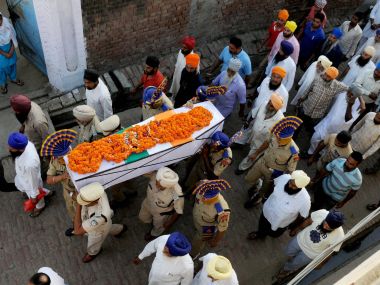Psy-ops are surreal. But fighting with highly-motivated Maoists require a fighting-fit war machine which can tackle the menace on the ground. It is real and bloody. The chest-thumping leadership of the Indian security agencies have learnt to live more in an imaginary than the real world.
The security forces’ repeated failure at Sukma in Chattisgarh perfectly illustrates this harsh reality. It does not require the skill of a genius to know that Sukma has emerged as the strongest Red bastion in the recent past. In the UPA regime, this area witnessed fierce encounters with Maoists who always gave security forces a bloody nose. That the security forces are fighting an unequal battle became clear on 6 April, 2010 when 75 CRPF jawans were killed in Chattisgarh’s Dantewada. Since then there have been many cases in which the security forces were at the receiving end.
The Sukma killings has once again reinforced the impression that India’s internal security doctrine continues to be guided by “chalta hai (business as usual)” approach. On the other hand, they have mastered the art of chest-thumping and vacuous bravado when it comes to psy-ops.
Remember the manner in which the armed forces claimed to have crossed over to Mayanmar to teach a lesson to Naga insurgents (Khaplang group) after 16 jawans of Indian Army were killed in Chandel district of Manipur in 2015. This was followed by another killing of six Assam rifles jawans in the same district. Instead of taking the enemy head on, the Assam rifles launched a psy-op and claimed to have conducted surgical strikes across the border through whatsapp messages. The fact that they dragged the Prime Minister’s name into it got the goat of the home ministry and defence ministry.
But this is not an isolated instance. Just after the Uri attack, the brigade headquarter of the army came out with the claims of eliminating 10 hardcore terrorists along the border. The subsequent investigations prove that once again the claim was the part of psy-ops which has nothing to do with the ground reality.
But unlike the problems in North East and Kashmir, where insurgency is stoked by foreign agencies, the “left-wing extremism” is entirely home grown and had taken firm roots in large swathes of the country. It may appear to dormant in Bihar and Uttar Pradesh for the time being but there is no denying the fact that its influence in eastern part of Uttar Pradesh and certain parts of Bihar is no less lethal than its hold in Chattisgarh, Jharkhand, Odisha, Telangana and Andhra Pradesh. In Union Home Minister Rajnath Singh’s home district, Chanduali, near Varanasi, the left-wing extremism has developed a strong base. There are areas just adjacent to the Prime Minister’s constituency where writ of the Indian state often becomes irrelevant.
Former Prime Minister Manmohan Singh was perfectly accurate when he diagnosed left-wing extremism the biggest threat to the country. But what followed up his former Home Minister P Chidambaram was once again a “chest-thumping” approach by launching an operation known as “operation green hunt” (though Chidambaram subsequently denied that he ever used that phrase). It did not yield any positive result as it lacked a holistic approach to the problem. Chidambaram’s folly is getting compounded by the Narendra Modi government in its worst form. Despite the lapse of three years, there is internal security doctrine which is rigorously followed. The Sukma killing of 25 jawans raises pertinent questions:
1. Why a trained team of soldiers get overpowered by a group of Maoists? Is there something fundamentally wrong with forces’ training. 2. Are the soldiers of the CRPF adequately briefed and trained about Naxals’ method of operation and topography? 3. Why does such a deployment take place in most casual manner with no local police assistance or presence of an IPS officer? 4. Do we senselessly deploy the forces without taking into account their motivation level?
The Sukma killing is not a challenge which can be brushed aside by psy-ops. Nobody knows it better than flamboyant national security advisor Ajit Doval that answer to these queries lies in evolution of a coherent and holistic internal security doctrine to regulate training, motivation and deployment of forces for internal security purposes. The impression that the country’s internal security is being pulled in different direction by the home ministry and the NSA would make the matter worse. And it will be a disease worst than remedy if the leadership of the security forces resort to psy-ops to overcome their follies.


)




)
)
)
)
)
)
)
)